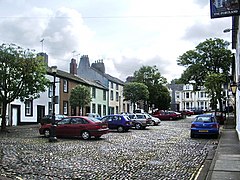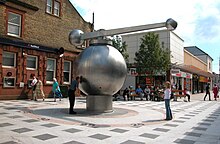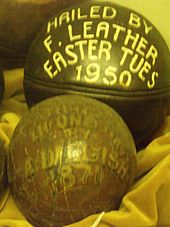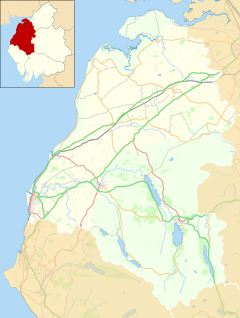Workington
| Workington | |
|---|---|
 Portland Square, 2007 | |
Location withinCumbria | |
| Population | 25,207 (2011)[1] |
| OS grid reference | NX996279 |
| •London | 259 mi (417 km)SE |
| Civil parish |
|
| Unitary authority | |
| Ceremonial county | |
| Region | |
| Country | England |
| Sovereign state | United Kingdom |
| Post town | WORKINGTON |
| Postcode district | CA14 |
| Dialling code | 01900 01946 |
| Police | Cumbria |
| Fire | Cumbria |
| Ambulance | North West |
| UK Parliament | |
Workington/ˈwɜːrkɪŋtən/is a coastal town andcivil parishat the mouth of theRiver Derwenton the west coast inCumbria,England. At the2011 censusit had a population of 25,207.[1]
Location[edit]
The town is 32 miles (51 kilometres) south-west ofCarlisle,8 miles (13 km) north-east ofWhitehaven,7 miles (11 km) west ofCockermouth,and 5 miles (8 km) south-west ofMaryport.
History[edit]
The area around Workington was long a producer of coal and steel.
Between 79 and 122 CE,Roman forts,mile-forts and watchtowers were built along the Cumbrian coast,[2]: 10 as defences against attacks by theScotiof Ireland and theCaledonii,the most powerful tribe in what is now Scotland.[2]: 11 The 16th-centuryBritannia,written byWilliam Camden,describes ruins of these defences.[3]
AViking swordwas discovered at Northside. This is seen to suggest there was a settlement at the river mouth.[4]
The place-name Workington is first attested in anAnglo-Saxon charterof 946, asWurcingtun.It appears asWirchingetonain about 1150, meaning "the town or settlement of Weorc or Wirc's people".[5]
Several bridges were damaged or destroyed by the River Derwent during the2009 Workington floods.
Regeneration[edit]

In 2006, Washington Square, a £50 million shopping centre and mixed-use complex, was opened to replace the run-down St John's Arcade, built in the 1960s and 1970s.[6][7]In 2007, the Royal Institution of Chartered Surveyors named Washington Square the "best commercial project" inNorth West England.[8]
Works ofpublic artinstalled in the town centre include:
- Glass canopies designed by Alexander Beleschenko[9]
- The Coastlineby Simon Hitchens[10]
- The Hubby BASE Structures and Illustrious[11]
- The Grilles architectural metalwork at Central Car Park byTom Lomaxin association with pupils from St Patrick's Primary School[12]and Alan Dawson.[13]
- Central Way public toilets with tiles designed in collaboration by ceramic artist Paul Scott and writer Robert Drake, in addition to a fish tank containing species from theSolwayprovided by the Lake District Coast Aquarium inMaryport[14]by Paul Scott and Robert Drake
- Lookout Clock, an interactive town clock designed by Andy Plant and Matt Wand[15]
While efforts have been made to find local names for the major streets of the new shopping centre, the initial planning title of Washington Square has been retained.[16]
Workington Stadium plans[edit]
In February 2019 plans for a new stadium for Workington were announced. This would in involve the demolition of Borough Park and Derwent Park.[17]
In June 2019, it was announced by the new leadership ofAllerdale Borough Councilthat a new sports stadium would not be built.[18][19][20]
Cloffocks development[edit]
A plan to build a 92,900 sq ft (8,630 m2)TescoExtra store on the Cloffocks provoked controversy and opposition from local people; a planning application was placed in 2006 by Tesco, after it acquired the Cloffocks site for £18 million;[21]Tesco had been competing withAsdafor the site since 2003.[22][23]Campaigners opposed the sale, stating that the land was common ground and belonged to the people of Workington.[24]In 2010 the Countess of Lonsdale invoked her rights to mine the land, in an attempt to prevent the development.[25]In 2011 a closed meeting of Allerdale councillors discussed the sale of the site,[26]but the council rescinded on its decision to sell it to Tesco in June 2011. Tesco stated that it was still seeking a site for a store of around 60,000 sq ft (5,600 m2) Workington to replace the established one.[27]
Closure of MEP's European Parliament office[edit]
In 2014, North West MEPJulie Wardclosed her Workington office and relocated it toManchester.[28][29][30]
Workington man[edit]
During the2019 general election,the concept of the "Workington man"was devised by a think tank as a key election target.[31][32][33]
In November 2019,Nigel Faragevisited Workington to campaign on behalf of theBrexit Party.[34][35][36]
Governance[edit]
The town is part of theparliamentary constituencyofWhitehaven and Workington.In the2024 general election,theLabour Partycandidate for Whitehaven and Workington,Josh MacAlister,was elected as theMember of Parliament(MP), with a 31.7 per cent Labour majority by a margin of 13,286 votes.[37]
Historically it has been a Labour-supporting area, the town had elected a Conservative MP only twice sinceWorld War II,at the1976 by-electionand2019 general election.[38][39]
BeforeBrexit,Workington was in theNorth West EnglandEuropean Parliamentary Constituency.
Forlocal governmentpurposes, Workington is administered byCumberland.
It was formerly covered by the Seaton + Northside, St Michaels, Moorclose + Moss Bay, Harrington + Salterbeck, and St Johns wards onAllerdale Borough Council.The divisions forCumbria County Councilwere Seaton, St Michaels, St Johns + Great Clifton, Moorclose + Moss Bay, and Harrington.
Workington has aparish council:Workington Town Council.[40]The current mayor (2024–2025) is Neil Schofield.[41]
Geography[edit]
Workington lies astride theRiver Derwent,on the West Cumbrian coastal plain. It is bounded to the west by theSolway Firth,part of theIrish Sea,and to the east by theLake District.
The town has various districts, many of them established ashousing estates.North of the river these includeSeaton,Barepot,Northside, Port and Oldside. On the south side are the districts of Stainburn, Derwent Howe, Ashfield, Banklands, Frostoms (Annie Pit), Mossbay, Moorclose,Salterbeck,Bridgefoot,Lillyhall,Harrington,High Harrington, Clay Flatts, Kerry Park, Westfield andGreat Clifton.The Marsh and Quay,[42]a large working-class area of the town around the docks and a major part of the town's history, was demolished in the early 1980s. Much of its former area is now covered by Clay FlattsIndustrial Estate.
Economy[edit]
Iron and steel[edit]

The Cumbria iron-ore field lies to the south of Workington, and produced extremely high gradephosphorus-freehaematite.The area had a long tradition of ironsmelting,but this became particularly important with the invention bySir Henry Bessemerof theBessemer process,the first process formass productionofmild steel,which previously had been an expensive specialist product. For the first 25 years of the process, until Gilchrist and Thomas improved upon it, phosphorus-free haematite was required. With Cumbria as the world's premier source, and the local coalfield providing energy for steel production, the world's first large-scalesteelworkswas opened in the Moss Bay area of the town. The Bessemer converter continued to work until July 1974.[43][44]The Moss Bay Steelworks closed in 1982, despite receiving notable infrastructural investment and improvement almost immediately before the closure.
During theSecond World War,a strategically important electric steel furnace which produced steel for aircraft engineball bearingswas moved to Workington fromNorwayto prevent it falling intoAxishands.
Workington was the home ofDistington Engineering Company(DEC), the engineering arm ofBritish Steel Corporation(BSC), which specialised in the design ofcontinuous castingequipment. DEC, known to the local people as "Chapel Bank", had an engineering design office, engineering workshops and a foundry that at one time contained six of the sevenelectric arcfurnaces built in Workington. The seventh was situated at the Moss Bay plant of BSC. In the 1970s, as BSC adapted to a more streamlined approach to the metals industry, the engineering design company was separated from the workshops and foundry and re-designated as Distington Engineering Contracting. Employing some 200 people, its primary purpose was the design, manufacture, installation and commissioning of continuous casting machines. This business is now owned by theTATA Groupand employs 400 staff.

One offshoot of the steel industry was the production of railway rails. Workington rails were widely exported and a common local phrase was that Workington rails "held the world together." Originally made from Bessemer steel, but after the closure of the Moss Bay Steelworks, steel for the plant was brought by rail fromTeesside.The plant was closed in August 2006, but welding work on rails produced atCorus Groups' French plant inHayangecontinued at Workington for another two years, as theScunthorpesite initially proved incapable of producing rails adequately.
After coal and steel[edit]
After the loss of the two industries on which Workington was built, coal and steel, Workington and the whole of West Cumbria became an unemployment blackspot. Industries in the town today include chemicals, cardboard, the docks (originally built by the United Steel Co.),waste managementandrecycling old computersfor export, mainly to poorer countries. The town also houses theBritish Cattle Movement Service,a government agency set up to oversee the British beef anddairy industryafter theBSEcrisis in Britain. It is based in the former steelworks offices. Many Workington residents are employed outside the town in the nuclear industry located in and aroundSellafield,West Cumbria's dominant employment sector.
Vehicle Manufacture[edit]

British Leylandopened a factory in Lillyhall, just outside Workington, initially to build theLeyland Nationalbus in the 1970s and 1980s. Produced primarily for the state-ownedNational Bus Company,the Leyland National was styled by Italian designerGiovanni Michelotti,and included a roof-mounted heating unit in a pod at the rear of the bus. The Lillyhall factory later built theLeyland Titan,Leyland OlympianandLeyland Lynxbuses.
In the 1980s, Leyland manufacturedPacerrailbus andSprinter-type commuter trains at Workington. The bodyshells of the Pacer trains were based on the Leyland National bus design, designed as a cheap stop-gap byBritish Rail.
Volvo BusesacquiredLeyland Busesin 1988. By 1993, the factory had closed with the loss of 200 jobs. The former bus plant is now a warehouse for the logistics companyEddie Stobart,which bought the property in 1995.
Transport[edit]
Workington is linked by theA596 roadtoMaryport,toWhitehavenviaA595 road,by theA66 roadtoPenrithand continues toScotch Cornerin County Durham. The town hasits own bus stationand bus services to other towns and villages inCumbria,such asCockermouth,Keswick,Penrith,Carlisle,Wigton,Maryport,Whitehaven,Frizington,EgremontandThornhill.
TheCumbrian Coast lineprovides rail connections from Workington railway station toCarlisleandBarrow-in-Furness,with occasional through trains toLancasterandPreston.
Workington North railway stationopened on 30 November 2009 as a temporary means of crossing the river after road bridges had been closed by flooding.[45]A free train service between Workington (Main) andMaryportwas funded by the government.
The Workington Transport Heritage Trust,[46]preserves the transport heritage of Workington and the surrounding area and is run by volunteers.
Workington was the headquarters of the haulage company J. Roper (Workington) Ltd, which was based in Moss Bay.
Workington is also home to the headquarters of family haulage business J.R Dixon Ltd
Arts and entertainment[edit]

Workington is home to three theatres: theCarnegie Theatre,Theatre Royal andWorkington Opera House.In the past Workington was a big town for variety acts and theatre and hosted many top acts includingTommy CooperandShirley Bassey.Workington Opera Housealso hosted many circus shows that included elephants and other circus animals performing on stage.
TheCarnegie Theatreand Theatre Royal are still open and put on performances all year round. TheWorkington Opera Houseis currently closed after its last use as abingohall. The"Opera Action"group plans to restore it as a working theatre.[citation needed]
The town once had four cinemas (the Carnegie, the Hippodrome, the Oxford and the Ritz), all now closed. There remains only the Parkway Cinema atDunmail Park.During the 1950s, films were also shown at the Opera House.
Cultural festivals[edit]
On 19 September 2009, Valentine Rock took place; a 19-band charity music festival. It was staged at the Ernest Valentine Ground home of Workington Cricket Club. Artists included The Chairmen, Novellos, With Lights Out, Volcanoes, Breed, Colt 45, Relics, Telf, Thir13een, Slagbank, Hangin' Threads and Hand of Fate. Profits went to theRNLIandWest Cumberland Lions.[47]
In 2008, the Paint Your Town Red Festival invitedLiverpoolcomic and actorRicky Tomlinson.Described as 'The biggest free festival in Workington's history', the 2008 festival included a free children's fun fair in Vulcan Park and stage and street entertainment. Attractions included "Jimmy James and his Soul Explosion", "Dearham Band" and theall-female band"Irresistible". Keswick's "Cars of the Stars" museum provided a stunt driving display.
Media[edit]
Local news and television programmes are provided byBBC North East and CumbriaandITV Border.Television signals are received from theCaldbeckand local relay transmitters.[48][49]
Local radio stations areBBC Radio Cumbriaon 95.6 FM,Greatest Hits Radio Cumbria & South West Scotlandon 102.2 FM and Workington Academy Radio, a student based radio station that broadcast to theWorkington Academy.[50]
The town is served by the local newspaper, Times & Star.[51]
Sport[edit]
Uppies and Downies[edit]

Workington is home to theball gameknown asUppies and Downies,a traditional version of football withmedievalorigins inmob footballor an even earlier form.[52][53][54][55]Since 2001, matches have raised over £75,000 for local charities.[56][57][58]An Uppies and Downies ball is made from four pieces of cow leather. It is 21 inches (53 cm) in circumference and weighs about two and a half pounds (1.1 kg). Only three hand-made balls are produced every year and each is dated.
Football[edit]
The town has a football team,Workington A.F.C.,with its stadium atBorough Park.Formerly a professionalfootball teamit now competes as anon-League club.[59]"Dronnies", a group of steel workers that had migrated to the town fromDronfield,Derbyshire,[60]formed the nucleus of the originalWorkington F.C.in 1888.[61]: 109 It was one of the first teams managed byBill Shankly.
Workington A.F.C.was replaced in the Football League byWimbledon F.C.in 1977.
Rugby League[edit]
The town has a semi-professionalrugby leagueteam,Workington Town,based atDerwent ParkFibrus Community Stadium.
Rugby Union[edit]
Workington is the home to the rugby union teamWorkington Zebras,which plays its matches on the Ellis Sports Ground.
Bowling[edit]
There are two bowling greens, one in Vulcan Park and another on High Cloffocks, south of the River Derwent. Teams and individuals from both greens compete in local, regional and national competitions.
Golf[edit]
Workington's firstgolf clubappeared in 1893 and played north of theRiver DerwentnearSiddick.Known as West Cumberland Golf Club, it used a nine-hole course until theFirst World War,when it closed. After the war the club formed again as Workington Golf Club and moved to the present Hunday Wood location. Five-times Open Champion and renowned course architectJames Braidwas consulted on the layout. Considered "one of the premier courses in Cumbria", it was influenced in the 1950s by F. G. Hawtree[62][63]and by Howard Swan today.[64]
Speedway[edit]
Workington Cometsare the town's professionalspeedwayteam,[65]which competes in the British Speedway Premier League.[66]
BeforeWorld War IIracing was staged at Lonsdale Park, next to Borough Park, on the banks of theRiver Derwent.The sport did not return to the town until 1970, when it was introduced to Derwent Park by local entrepreneur Paul Sharp and Ian Thomas, who is the present team manager (2009). In 1987, Derwent Park was a temporary home to theGlasgow Tigers,which briefly became the Workington Tigers before withdrawing from the league. Speedway returned to Workington,[67]and the team has operated with varying degrees of success, but in 2008 it won the Young Shield[68]and the Premier League Four-Team and Pairs Championships. An academy team under the banner of Northside Stars, develops young riders who show potential at the Northside training track and may make future first teams.[69]
Cricket[edit]

Workington Cricket Club plays at the Ernest Valentine Ground, on the High Cloffock near the River Derwent and the town centre.[70]It is a thriving club with three senior teams and a growing junior section putting out six teams. It is affiliated to Cumbria Cricket League, Cumbria Cricket Board, Cumbria Junior Cricket League and the West Allerdale & Copeland Cricket Association.
Cumbria Cricket Board Open Courses are led by coaches at the town's Stainburn School. These are open to Years 4–10 pupils.[71]
Angling[edit]
Workington and District Sea Angling Club takes part in regular monthly matches. It meets every month in the Union Jack Club, Senhouse Street, Workington. It also arranges tuition for its anglers.[72]
Freshwater anglers are active on local rivers, especially the River Derwent.[73]
Athletics[edit]
Workington has opportunities for track and field,triathlon,road running,cross-country,fell runningandorienteering.All of its schools and clubs are affiliated to the Cumbria Athletics Association,[74]except orienteering which is organised through its own national federation.[75]Athletes tend to join clubs which concentrate on their particular discipline. Cumberland Fell Runners;[76]Cumberland Athletics Club;[77]Derwent and West Cumberland AC; Seaton Athletics Club; Workington Zebras AC and West Cumberland Orienteering Club[78]are the most popular at present.
Primary schools have a well organised inter-school programme.[79]Secondary schools focus especially on the Allerdale District School's Championships, which lead on to the Cumbria Schools Championships. The results of Cumbria's championships guide selection of the county teams to compete in theEnglish Schools Athletic AssociationChampionships. Over the years, Workington athletes have earned English Schools Championship honours.
Motorbike road riding[edit]
There is a Cumbria Coalition of Motorcycle Clubs. The West Cumbrianmotorcycle club,the Roadburners,[80]was established in 1989 and regularly features at local and national motorbike rallies and charity road runs. It welcomes new members interested in multi-cylinder machines. The National Chopper Club also has some local members.[81]
Notable people[edit]
Twin towns[edit]
 Selm,Germany
Selm,Germany Val-de-Reuil,France
Val-de-Reuil,France
See also[edit]
- Listed buildings in Workington
- The Stars Look Down,film partly filmed at St Helens Siddick Colliery at Workington.
- Workington Academy
- Derwent Park
- Borough Park (Workington)
- Lakes College
References[edit]
- ^ab"Population Density, 2011".Area: Workington (Parish).Office for National Statistics.
- ^abRichard L. M. Byers (1998).History of Workington: An Illustrated History from Earliest Times to 1865.Richard Byers.ISBN0-9529812-2-X.
- ^"Cumberland".The Philological Museum, hosted byThe Shakespeare Institute of the University of Birmingham.
- ^"The West Seaton Viking Sword".British and Irish Archaeological Bibliography.
- ^Eilert Ekwall,The Concise Oxford Dictionary of English Place-names,p. 534.
- ^"Washington Square, Workington".S Harrison Developments Ltd.
- ^"Town Centre Redevelopment".Allerdale Borough Council.Archived fromthe originalon 16 May 2011.Retrieved19 October2006.
- ^Kerrush, G. (25 May 2007)."Town Centre Wins Top Award".Times & Star.
- ^"The Beleshenko Glass Canopies".Allerdale Borough Council.
- ^"Coastline".Allerdale Borough Council.
- ^"The Hub".Allerdale Borough Council.
- ^"The Grilles of Central Car Park".Allerdale Borough Council.
- ^"Alan Dawson Associates Ltd – architectural metalwork".Adaptahaus.
- ^"Central Way Timeline Toilets".Allerdale Borough Council.
- ^"The New Town Clock".Allerdale Borough Council.
- ^Dixson, Nicole (13 December 2002). "Thumbs up for the new look".West Cumberland Times and Star.
- ^"Plans lodged to demolish Borough Park".5 February 2019.
- ^"new stadium plan rejected by Allerdale Council".28 June 2019.
- ^"Workington Rugby League World Cup withdrawal 'lost opportunity'".BBC News.4 July 2019.
- ^"Stadium for Workington".
- ^McGowan, P. (18 May 2006)."Tesco Puts in Plans for Cloffocks".Times & Star.
- ^Breen, C. (27 October 2005)."Tesco Wins Battle for Workington Supersite".Times & Star.
- ^"Tesco Wins Battle of Cloffocks".Times & Star.22 January 2004.
- ^Meller, B. (24 November 2006)."Move to Stop Cloffocks Sale".Times & Star.
- ^Coleman, Phil (6 April 2010)."Countess Could Hold Key to Stopping Tesco's New Store Plan".Times & Star.
- ^"D-Day for Future of Tesco's New West Cumbrian Store".Times & Star.24 March 2011.
- ^"Tesco U-Turn Over Plans for Store in Cumbrian Town".Times & Star.30 June 2011.
- ^"North West MEP Julie Ward quits Workington".22 September 2016.
- ^"North West MEP Julie Ward accused of turning back on Cumbria".25 August 2016.
- ^"Only North West MEP Julie Ward based in Cumbria, closes her office".23 August 2016.
- ^"General Election: Who is target voter Workington Man?".BBC News.30 October 2019.
- ^Nandy, Lisa (31 October 2019)."Workington Man is London's latest stereotype for the northern voters it neglects".The Guardian.
- ^"Workington man profile draws criticism from town residents".31 October 2019.
- ^"Nigel Farage addresses the people of Workington".6 November 2019.
- ^"nigel-farage-accosted-by-angry-voters-on-visit-to Workington".
- ^"The Brexit Party leader was confronted by Labour supporter and second referendum supporter Karl Connor".6 November 2019.
- ^"Whitehaven and Workington - General election results 2024".BBC News.
- ^"A vision of Britain website – general elections section".Retrieved27 April2012.
- ^"Workington parliamentary constituency – Election 2019".
- ^"Workington Town Council".
- ^Town Council site
- ^"The Marsh, Workington".users.globalnet.co.uk.
- ^Baggley, Phil."The Last Blow".Workington Iron and Steel.Retrieved9 January2016.
- ^"Workington Steelworks, site of".Engineering Timelines.Institution of Civil Engineers.Retrieved9 January2016.
- ^Kelly, Jon (24 November 2009)."Rail station hope for the town cut in two".BBC News.
- ^"Workington Transport Heritage".
- ^"Open Air Music Festival Planned for Workington".Times & Star.7 August 2009.
- ^"Caldbeck (Cumbria, England) Full Freeview transmitter".May 2004.
- ^"Workington (Cumbria, England) Freeview Light transmitter".May 2004.
- ^"Workington Academy Radio".
- ^https://www.timesandstar.co.uk/
- ^"The Uppies and Downies of England's Great Traditions".The Whitehaven News.15 February 2008. Archived fromthe originalon 3 December 2013.
- ^"Football Extraordinary (Timaru Herald, Volume LXII, Issue 2977, 14 June 1899, Page 4)".National Library of New Zealand.
- ^"Artist Captures Uppies and Downies".News and Star.9 May 2008. Archived fromthe originalon 3 December 2013.
- ^Henricks, Thomas S. (1991).Disputed Pleasures: Sport and Society in Preindustrial England.Greenwood Publishing Group.ISBN0-313-27453-3.
- ^"Don't View Uppies and Downies Through Rose Tinted Spectacles".Times & Star.3 September 2009. Archived fromthe originalon 2 December 2013.
- ^"Uppies and Downies raise £7,000 for RNLI".Times & Star.2 May 2008. Archived fromthe originalon 2 December 2013.
- ^"Uppies and Downies Worldwide".Times & Star.24 February 2006. Archived fromthe originalon 24 November 2013.
- ^"Honours".Sheffield F.C.
- ^Eade, Paul (2003).Images of Sport – Workington Association Football Club.Tempus Publishing. p. 13.ISBN0752428187.
- ^Richard L. M. Byers (2003).The History of Workington, An Illustrated History from 1866 to 1955, Volume 2.Richard Byers.ISBN0-9529812-5-4.
- ^"Fred W Hawtree 1916–2000 in Memoriam".European Institute of Golf Course Architects.
- ^"The Early Years".Hawtree Limited.
- ^"Swan Golf Design".Swan Golf Designs.
- ^"Workington Speedway".Workington Comets.
- ^"British Speedway's Premier League".British Speedway.
- ^Gibson, V. (16 March 2007)."Comets Roaring to Go".News and Star.
- ^"Workington Comets Beat Berwick to Win Speedway's Young Shield".News and Star.30 October 2008. Archived fromthe originalon 17 September 2009.
- ^Walsh, John (2 March 2008)."Comets Academy Rides Again".News and Star.
- ^"Workington CC".play-cricket.com.
- ^"West Allerdale and Copeland Cricket Association Website".LeagueRepublic.
- ^"Sea Angling".Times & Star.16 January 2009.
- ^"Windermere, Ambleside & District Angling Association".lakedistrictfishing.net.
- ^"Cumbria AA".Northern Athletics.
- ^"Orienteering in the North West of England".North West Orienteering Association.
- ^"Homepage".Cumbria Fell Runners.
- ^"Welcome to our website".Cumberland Athletic Club.
- ^"Welcome".West Cumberland Orienteering Club.
- ^"Orienteering Pupils Dash Round Workington Schools".Times & Star.15 May 2009.
- ^"Roadburners".Piczo.
- ^"Homepage".National Chopper Club.
External links[edit]
- Cumbria County History Trust: Workington(nb: provisional research only – see Talk page)
- Allerdale Borough Council
- Workington Tourism Guide



